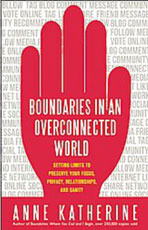"What is the purpose of phones, texting, tweets, or using Facebook? Setting aside the organizational support given by a smartphone, what is the goal of using these devices?
"Communication, obviously. But I propose that there's a higher purpose: connection. I propose that we want to keep in touch with people we care about. We want to know what they are doing and thinking. We want to know about their concerns and celebrations. And we want to share ours with them. This is a desire for connection, for intimacy.
"Since the advent of all our devices, are we more connected with the people in our lives, or less? I'd say we're connected with more people, including people who would be on the periphery of our lives if we wrote paper letters and put them in metal mailboxes — people we'd talk to a couple of times a year if we had only one phone plugged into a wall at home. Instead, those people can be in contact with us, and us with them, multiple times a week.
"But each of these contacts takes time.
"Where is the time coming from? It's pulled from family dinners, walks in the park, and intimate phone conversations, due to frequent momentary interruptions by a ringer or a vibration.
"Nearly every potentially intimate moment with the person you are with can be disrupted, and this changes the dynamic. When you know that your heart-to-heart talk can be interrupted, it adds a dimension of tentativeness, of suspense. You don't know exactly when an interruption will occur, but it's likely, so you might hold yourself back a bit, not wanting to get into a deep part of yourself and then go on hold. Even if the disturbance is as brief as the other person reading a short text or checking to see who's calling, it is still a halt in the flow that was building between you.
"Intimacy requires a protected space. I fear that a couple of generations have already entered adulthood primed for interruption, and that this is keeping them from accessing and gaining the skills for deeper union with fewer, but more significant, friends and mates.
"Once upon a time, teenagers spent long hours on the phone with a couple of their friends and the person they were going steady with. This bothered some parents, but therapists viewed it as part of adolescents' normal development of the capacity for intimacy.
"A teenage girl could pour her heart out to her best friend on the other end of the line and feel very close, because her friend's voice was in her ear. At the same time, because the two people were in separate locations, it wasn't too intimate. Either teen could regulate the closeness by finding a reason to hang up. After some internal regrouping — by doing homework or chores, talking to Mom, or playing with the cat — either teen could call back and reconnect until she reached her next limit of relationship tolerance.
"This was a transitional phase on the way to intimacy — an important building block that helped teenagers develop the capacity for vital and deep connections. If, these days, communications are frequently brief or interrupted, where is that development taking place?
"Today, texting, tweeting, emailing,-and posting on a wall do offer a way out when one's tolerance for relationship is reached — you can ignore a text or respond to an email weeks later — but what is offering a way back in? These truncated or public communications are not meant to be an end point.
"Is the plethora of condensed, broadcast, or one-sided messages creating a generation or a culture of people stuck at the level of adolescent development? I think there is some danger of being held at a level of connection that is meant to be just a section of the path on the way to the incredible experience of union that is true intimacy. I wonder if the fascination with celebrity lives or with marriages that result from a televised contest is a way of filling the emptiness of not achieving a deep bond, either with one's own self or with another, proximate person."
